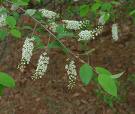Mountain Black Cherry Tree Information
Images of Mountain Black Cherry:






Mountain Black Cherry grows in the following 41 states and provinces:
Alabama, Arizona, Arkansas, Colorado, Connecticut, Delaware, Florida, Georgia, Illinois, Indiana, Iowa, Kansas, Kentucky, Louisiana, Maine, Maryland, Massachusetts, Michigan, Minnesota, Mississippi, Missouri, Nebraska, New Brunswick, New Hampshire, New Jersey, New Mexico, New York, North Carolina, Nova Scotia, Ohio, Oklahoma, Ontario, Pennsylvania, Rhode Island, South Carolina, Tennessee, Texas, Vermont, Virginia, West Virginia, WisconsinInformation about Mountain Black Cherry:
The Prunus Serotina is commonly known as the Black Cherry, Mountain Black Cherry, Rum Cherry, Wild Black Cherry as well as Wild Cherry.
The currently accepted scientific name of black cherry is Prunus serotina Ehrh. . Recognized varieties found in the United States and Canada include: var. serotina - black cherry var. alabamensis (Mohr) Little - Alabama black cherry var. exima (Small) Little - escarpment black cherry var. rufula (Woot. & Standl) McVaugh - southwestern black cherryBlack cherry grows in eastern North America from western Minnesota south to eastern Texas, and eastward to the Atlantic from central Florida to Nova Scotia . Outlying populations grow in central Texas; in the mountains of western Texas, New Mexico, and Arizona; and south in Mexico to Guatemala . The varieties are distributed as follows : typical black cherry (var. serotina) - from Nova Scotia west to central Minnesota, south to east Texas, and east to central Florida. Alabama black cherry (var. alabamensis) - from eastern Georgia west to northeastern Alabama, and south to northwestern Florida. Also local in South Carolina and North Carolina. escarpment cherry (var. exima) - found in the Edwards Plateau region of central Texas. southwestern black cherry (var. rufula) - in the mountains from western Texas to central Arizona, and south to northern and central Mexico. Black cherry occurs as scattered individuals in numerous forest types of the East (see SAF cover types listed). It is codominant in only one cover type, the black cherry-maple type (SAF 28) found in the Allegheny Plateau and Allegheny Mountain sections of New York, Pennsylvania, Maryland, and West Virginia . In this type, black cherry is a primary component along with red maple (Acer rubrum), sugar maple (A. saccharum), and white ash (Fraxinus americana). Other common associates include American beech (Fagus grandifolia), eastern hemlock (Tsuga canadensis), sweet birch (Betula lenta), yellow birch (B. alleghaniensis), yellow-poplar (Liriodendron tulipifera), cucumbertree (Magnolia acuminata), oak (Quercus spp.), and hickory (Carya spp.) .Some of the information provided here is attributed to:Uchytil, Ronald J. 1991. Prunus serotina. In: Fire Effects Information System, [Online]. U.S. Department of Agriculture, Forest Service, Rocky Mountain Research Station, Fire Sciences Laboratory (Producer). , available at the USDA Fire Effects Information System (FEIS) website